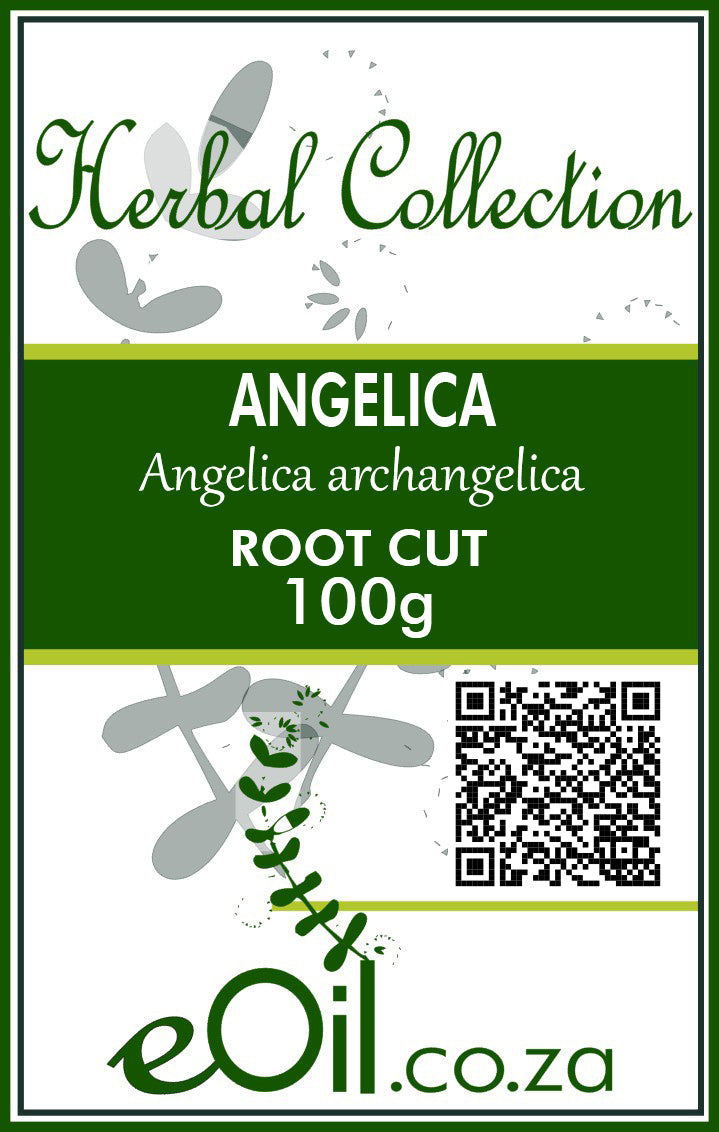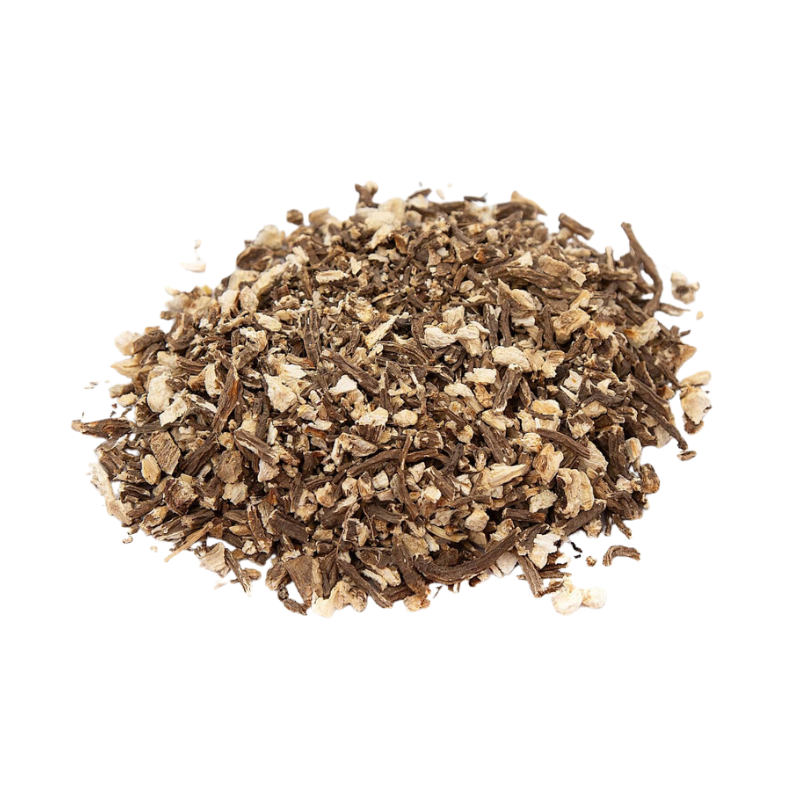Angelica Root Cut Dried Herb - Herbal Collection
Angelica Root Cut Dried Herb - Herbal Collection - 100 GR is backordered and will ship as soon as it is back in stock.
Description
Description
Angelica Root - Dried Cut Herb (*Angelica archangelica*)
Embrace a cornerstone of classic European herbalism with our premium Dried Cut Angelica Root. Known historically as "Holy Ghost Root" or "Wild Celery," Angelica archangelica is a powerful aromatic herb with a long history of use, especially for digestive and respiratory support.
As a dried, cut herb, it is ready for all your traditional at-home preparations, from bitter teas to warming herbal baths.
Key Traditional Uses & Applications:
Potent Digestive Tonic: This is Angelica's most famous use. It is a classic "bitter tonic" and carminative. A tea (infusion) made from the root is traditionally used to stimulate appetite, fire up digestion, and relieve discomfort from gas, bloating, indigestion, and colics.
Respiratory & Cold Support: As a "warming" herb, Angelica is a traditional go-to during cold and flu season. It is used to help soothe coughs and support the respiratory system.
DIY Herbal Preparations:
Herbal Tea: Steep in hot water to create a potent, warming, and bitter digestive tea.
Herbal Bath: Add to a warm bath for a comforting, aromatic, and warming soak.
DIY Tincture: Can be used as the base material for creating your own herbal tincture (macerated in alcohol).
Important Cautions:
Angelica Root can cause photosensitivity. Avoid direct, prolonged sun exposure if you consume it regularly or apply it to the skin (e.g., in a bath).
Do NOT use if pregnant or breastfeeding.
Consult a healthcare professional before use, especially if you have diabetes or are on any medication.
TRADITIONALLY USED FOR
Angelica root (Angelica archangelica) is a tall, perennial herb native to Europe and parts of Asia. The dried and cut root has been used for centuries to prepare a tisane, which is believed to possess various benefits, properties, and traditional uses:
Digestive aid: Angelica root tisane has been traditionally used to improve digestion, alleviate stomach cramps, reduce bloating, relieve symptoms of indigestion, and stimulate appetite.
Respiratory support: The herb has been used to treat respiratory issues such as coughs, bronchitis, asthma, and sinus congestion, due to its expectorant and anti-inflammatory properties.
Circulatory support: Angelica root is believed to help improve blood circulation, maintain healthy blood pressure levels, and alleviate symptoms related to poor circulation.
Women's health: The herb has been traditionally used to alleviate menstrual cramps and discomfort, as well as to help regulate the menstrual cycle.
Nervous system support: Angelica root tisane is thought to have a calming effect on the nervous system, making it potentially useful for reducing anxiety, stress, and promoting relaxation.
Diuretic properties: The herb has been used as a diuretic, which may help with urinary tract infections, kidney stones, and fluid retention by promoting urine production and flushing out toxins.
Immune system support: Angelica root is believed to have immune-boosting properties due to its antimicrobial, antibacterial, and antiviral effects.
To make angelica root tisane, steep 1-2 teaspoons of dried, cut angelica root in a cup of boiling water for 5-10 minutes. Strain the infusion and drink it as needed for the desired effect.
Please note that pregnant and nursing women, as well as individuals with certain medical conditions, should consult a healthcare professional before using angelica root tisane.
The herb may interact with medications or cause allergic reactions in some individuals.
Additionally, angelica root contains coumarin compounds, which may increase the risk of bleeding when taken in large amounts or with certain medications, such as anticoagulants.
INFORMATION
Source : http://www.wikiphyto.org/wiki/Angelica
Reference on http://www.wikiphyto.org
Translation in English by Google Translate (go to the page of the source linked | on Chrome cellphones go on the 3 dots on the top right and select translate in your preferred language | on laptop right click your mouse and select option translate when hoovering on the page
plant name
Angelica, Angel Grass , Holy Spirit Herb
International Latin denomination
Angelica archangelica L. ; synonyme : Archangelica officinalis (Moench.) Hoffm.
botanical family
Apiaceae ( Umbelliferae )
Description and habitat
- Beautiful biennial plant reaching 1 m to 2.5 m in height, with a reddish cylindrical stem, hollow, with large bi- or tripinnate leaves
- Flowers grouped in large compound umbels, yellowish green, up to 40 cm in diameter
History and tradition
- It was called Herb of the Holy Spirit because it is said to have saved Milan from the plague in 1510
- Its name comes from the fact that it blooms on Saint Michael the Archangel
- Cazin reports the case of Annibal Camoux, who died in 1759 at the age of 121 years and 3 months, who continually chewed angelica root [1]
- Another species, Angelica dahurica , is vasorelaxant and antihypertensive [2]
- The Chinese angelica Angelica sinensis possesses a gynecological tropism
Parts used
- Underground part (rooting strain)
- Root or fruit essential oil
Dosage forms available
- Underground Part Tincture
- Root and fruit essential oil
- Fluid extract
- Dry extract
Usual dosages
- In infusion of 15 minutes at 20 g/litre, the recommended dose is 250 to 500 ml per day
- That is 5 to 10 grams per day
Composition
Main components of the plant
- Essential oil (0.35 to 1.3%) with monoterpene hydrocarbons : alpha-phellandrene and beta-phellandrene , alpha-pinene , etc.
- Coumarins and furanocoumarins : osthenol and osthol , umbelliferone , chromone peucenin-7-methylether ; imperatorine and isoimperatorine
- Flavonoids : Archangelenone ( flavanone )
- Others: sitosterol , phenolic acids ( caffeic acid , chlorogenic acid , ferulic acid ), tannins
Main components of buds or young shoots
Main components of essential oil
- Monoterpene hydrocarbons : alpha-phellandrene and beta-phellandrene 13.5%, alpha-pinene 25%, beta-pinene , sabinene , delta-3-carene , myrcene , limonene 8% [3]
- Sesquiterpènes (béta-bisabolène, bisabolol, béta-caryophyllène)
- Macrocyclic lactones (7 to 20% in essential oils from Nordic countries [4] , less abundant in the temperate zone [5] ) , which give a musky smell:
- Ambrettolide (sometimes called ambrettolure ) and pentadecanolide = oxacyclohexadecan-2-one = cyclopentadecanolide [6] (sometimes called pentadecanolide ), 13-tridecanolide , 15-pentadecanolide ( muskalactone ), 17-heptadecanolide
- 1.8 cineole 14.5% (inconstant)
- Single coumarins and more than 20 furanocoumarins ( bergapten , isoimperatorin , xanthotoxin , angelicin , archangelicin )
- Hexamethylphthalate in fruit essential oil
Properties
Plant properties
- Stimulates gastric and pancreatic secretions, cholagogue (bitter aromatic flavor) [7]
- Appetizer and stomachic, carminative, anti-ulcer
- Spasmolytic of the intestine and trachea of guinea pig, anti-asthmatic [8]
- Hepatoprotector [9]
- Anxiolytic ( imperatorine ) [10] , [11] , [12] , especially the root [13]
- Antidepressant activity by MAOI effect, inhibition of mono-amine oxidase ( angelicin , bergapten ) [14]
- Improves memory (in mice) [15] , improves behavioral and psychological symptoms of certain dementias such as dementia with Lewy bodies ( ferulic acid ) [16]
- Neuroprotective, improves cognitive impairment induced by lipopolysaccharide and neuroinflammation ( imperatorine ) [17]
- Would be active on the hypercorticism of the phases of prolonged stress
- Antimicrobial, expectorant, antiseptic
- diuretic, emmenagogue
- Inhibition of platelet aggregation (root extract)
- Calcium antagonist activity greater than that of verapamil by archangelicin [18] , [19]
- Radio-protective, protects the mouse from damage caused by gamma radiation [20] , [21] , [22] , [23]
- Cytotoxic on pancreatic cancer ( furanocoumarins ) [24]
- Cholinesterase inhibition [25]
Bud properties
Properties of essential oil
- Antimicrobienne (Clostridium difficile, Clostridium perfringens, Enterococcus faecalis, Eubacterium limosum, Peptostreptococcus anaerobius, Candida albicans) [26]
- The combination (1:1:1) essential oil of Angelica archangelica , phenyl ethyl alcohol and α-terpineol protects against mold and aflatoxin contamination of food products [27]
- Likely immunostimulatory
- Gut microbiota regulator
- Regulates the menstrual cycle and the female endocrine system (by ambrettolure and pentadecanolure ?)
- The essential oil of certain chemotypes is cytotoxic on breast and pancreatic cancers ( beta-phellandrene ) [28]
Indications
Indications of the whole plant (phytotherapy)
- Gastric dyspepsia and hyposecretions
- Feeling of satiety, flatulence
- Gastrointestinal cramps
- Gastric ulcers, gastritis
- Fibromyalgia [29]
- Insomnia of nervous origin ( essential oil )
- External route: rubefacient in neuralgia and rheumatism
Indications of the bud (gemmotherapy)
Specific indications of essential oil (aromatherapy)
- Insomnia of nervous origin, depressive syndromes
- neuralgia
- Premenstrual syndrome, dysmenorrhea, spaniomenorrhea
- Beta-phellandrene essential oil is cytotoxic on breast cancer and pancreatic cancer
Known or suspected mode of action
Usual formulations
- Classic galactogenic herbal tea formula:
- Angelica Angelica archangelica seeds...30 grams
- Green anise Pimpinella anisum seeds...30 grams
- Fennel Foeniculum vulgare seeds ... 30 grams
- Carvi carvi semences ... 60 grammes
- Hops Humulus lupulus cones ... 20 grams
- One teaspoon per cup. Boil 2 to 3 minutes, infuse 10 minutes. Drink 2 to 3 cups a day
Regulations
- French Pharmacopoeia list A (fruit and underground part)
Possible side effects and precautions for use
- Dermatitis by photosensitization [30] , but no risk with the infusion due to the low water solubility of furanocoumarins
- Potential interactions with warfarin (angelica root) [31]
Bibliographic references
- Go↑ Cazin FJ. Practical and reasoned treatise on native medicinal plants. Ed. de l'Envol. Mane. 1997. identical reissue of the 1868 original. Online at Pl@ntUse
- Go↑ Lee K, Shin M, Ham I, Choi H. Investigation of the mechanisms of Angelica dahurica root extract-induced vasorelaxation in isolated rat aortic rings. BMC Complementary and Alternative Medicine 2015, 15:395 (31 October 2015) Abstract texte intégral
- Go↑ Jean-Claude Chalchat & Raymond-Philippe Garry (1997) Essential Oil of Angelica Roots (Angelica archangelica L.): Optimization of Distillation, Location in Plant and Chemical Composition, Journal of Essential Oil Research, 9:3, 311-319, DOI: 10.1080/10412905.1997.10554250
- Go↑ Holm, Yvonne & Solberg, Svein & Hiltunen, R. (2009). Variation in Angelica archangelica root essential oils. Planta Medica - PLANTA MED. 75. 929. 10.1055/s-0029-1234418.
- Go↑ J. C. Chalchat & R. Ph. Garry (1993) Pentane Extracts of the Roots of Angelica archangelica L. from France, Journal of Essential Oil Research, 5:4, 447-449, DOI: 10.1080/10412905.1993.9698257
- Go↑ https://pubchem.ncbi.nlm.nih.gov/compound/235414 PubChem
- Go↑ Paloma Filliat. Plants of the Apiaceae family in digestive disorders. Thesis in pharmaceutical sciences. 2012. dumas-00740660. Full Text
- Go↑ Heo, J. C., & Lee, S. H. (2008). Amelioration of Asthmatic-Related Symptoms by an Aqueous Extract of Angelica archangelica L. Journal of Life Science, 18(10), 1336-1341.
- Go↑ Yeh ML, Liu CF, Huang CL, Huang TC. Hepatoprotective effect of Angelica archangelica in chronically ethanol-treated mice. Pharmacology. 2003 Jun;68(2):70-3. PMID 12711833
- Go↑ Budzynska B, Kruk-Slomka M, Skalicka-Wozniak K, Biala G, Glowniak K. The effects of imperatorin on anxiety and memory-related behavior in male Swiss mice. Exp Clin Psychopharmacol. 2012 Aug;20(4):325-32. PMID 22686497
- Go↑ Kumar D, Bhat ZA, Shah MY. Anti-anxiety activity of successive extracts of Angelica archangelica Linn. on the elevated T-maze and forced swimming tests in rats. J Tradit Chin Med. 2012 Sep;32(3):423-9. PMID 23297567
- Go↑ Kumar D, Bhat ZA, Kumar V, Shah MY. Coumarins from Angelica archangelica Linn. and their effects on anxiety-like behavior. Prog Neuropsychopharmacol Biol Psychiatry. 2013 Jan 10;40:180-6. PMID 22960104
- Go↑ Kumar D, Bhat ZA. Anti-anxiety Activity of Methanolic Extracts of Different Parts of Angelica archangelica Linn. J Tradit Complement Med. 2012 Jul;2(3):235-41. PMID 24716138
- Go↑ Kaur, A., Garg, S., Shiekh, B. A., Singh, N., Singh, P., & Bhatti, R. (2020). In silico studies and in vivo MAOA inhibitory activity of coumarins isolated from Angelica archangelica extract: an approach toward Antidepressant activity. ACS omega, 5(25), 15069-15076.
- Go↑ Budzynska B, Kruk-Slomka M, Skalicka-Wozniak K, Biala G, Glowniak K. The effects of imperatorin on anxiety and memory-related behavior in male Swiss mice. Exp Clin Psychopharmacol. 2012 Aug;20(4):325-32. doi: 10.1037/a0028391. PMID 22686497
- Go↑ Kimura T, Hayashida H, Murata M, Takamatsu J. Effect of ferulic acid and Angelica archangelica extract on behavioral and psychological symptoms of dementia in frontotemporal lobar degeneration and dementia with Lewy bodies. Geriatr Gerontol Int. 2011 Jul;11(3):309-14. doi: 10.1111/j.1447-0594.2010.00687.x. PMID 21272180
- Go↑ Chowdhury, A. A., Gawali, N. B., Shinde, P., Munshi, R., & Juvekar, A. R. (2018). Imperatorin ameliorates lipopolysaccharide induced memory deficit by mitigating proinflammatory cytokines, oxidative stress and modulating brain-derived neurotropic factor. Cytokine, 110, 78-86.
- Go↑ P. Härmälä, H. Vuorela, R. Hiltunen, Sz. Nyiredy, O. Sticher, K. Törnquist, S. Kaltia. Strategy for the isolation and identification of coumarins with calcium antagonistic properties from the roots of Angelica archangelica. Phytochemical Analysis, Volume 3, Issue 1, pages 42–48, January 1992 [1]
- Go↑ Pia Härmälä, Heikki Vuorela, Kid Törnquist, Raimo Hiltunen. Choice of Solvent in the Extraction of Angelica archangelica Roots with Reference to Calcium Blocking Activity. Planta Med 1992; 58(2): 176-183. PMID 1529031
- Go↑ Narimanov AA. [The antiradiation effectiveness of a mixture of Archangelica officinalis and Ledum palustre extracts in the fractionated gamma irradiation of mice]. Radiobiologiia. 1993 Mar-Apr;33(2):280-4. PMID 8502748
- Go↑ Narimanov AA. [The reproductive capacity of male mice protected against the superlethal action of gamma radiation by the administration of a mixture of Archangelica officinalis and Ledum palustre extracts]. Radiobiologiia. 1992 Mar-Apr;32(2):271-5. PMID 1598402
- Go↑ Narimanov AA, Miakisheva SN, Kuznetsova SM. [The radioprotective effect of extracts of Archangelica officinalis Hoffm. and Ledum palustre L. on mice]. Radiobiologiia. 1991 May-Jun;31(3):391-3. PMID 1887008
- Go↑ Khedr, M. H., Shafaa, M. W., Abdel-Ghaffar, A., & Saleh, A. (2018). Radioprotective efficacy of Ginkgo biloba and Angelica archangelica extract against technetium-99m-sestamibi induced oxidative stress and lens injury in rats. International journal of radiation biology, 94(1), 37-44.
- Go↑ Sigurdsson S, Ogmundsdottir HM, Gudbjarnason S. Antiproliferative effect of Angelica archangelica fruits. Z Naturforsch C. 2004 Jul-Aug;59(7-8):523-7. PMID 15813373
- Go↑ Senol, Fatma & Skalicka-Woźniak, Krystyna & Khan, Mahmud Tareq Hassan & Erdogan Orhan, Ilkay & Sener, Bilge & Głowniak, Kazimierz. (2011). An in vitro and in silico approach to cholinesterase inhibitory and antioxidant effects of the methanol extract, furanocoumarin fraction, and major coumarins of Angelica officinalis L. fruits. Phytochemistry Letters. 4. 462-467. 10.1016/j.phytol.2011.08.016.
- Go↑ Fraternale D, Flamini G, Ricci D. Essential oil composition and antimicrobial activity of Angelica archangelica L. (Apiaceae) roots. J Med Food. 2014 Sep;17(9):1043-7. doi: 10.1089/jmf.2013.0012. PMID 24788027
- Go↑ Prakash B, Singh P, Goni R, Raina AK, Dubey NK. Efficacy of Angelica archangelica essential oil, phenyl ethyl alcohol and α- terpineol against isolated molds from walnut and their antiaflatoxigenic and antioxidant activity. J Food Sci Technol. 2015 Apr;52(4):2220-8. doi: 10.1007/s13197-014-1278-x. PMID 25829603
- Go↑ Sigurdsson S, Ogmundsdottir HM, Gudbjarnason S. The cytotoxic effect of two chemotypes of essential oils from the fruits of Angelica archangelica L. Anticancer Res. 2005 May-Jun;25(3B):1877-80.
- Go↑ Kaur, A., Singh, N., Bhatti, M. S., & Bhatti, R. (2020). Optimization of extraction conditions of Angelica archangelica extract and activity evaluation in experimental fibromyalgia. Journal of Food Science, 85(11), 3700-3710.
- Go↑ EMEA European Medicines Agency, Committee on herbal medicinal products (HMPC) October 2007. Reflection paper on the risks associated with furocoumarins contained in preparations of Angelica archangelica L. Doc. Ref. EMEA/HMPC/317913/2006 EMEA
- Go↑ Heck AM, DeWitt BA, Lukes AL. Potential interactions between alternative therapies and warfarin. Am J Health Syst Pharm. 2000 Jul 1;57(13):1221-7; quiz 1228-30. PMID 10902065
- K. Ghedira, P. Goetz. Angelica archangelica L. (Apiaceae, Umbelliferae). Angelique. Practical medical material. Phytotherapy, October 2014, Volume 12, Issue 5, pp. 318–322
- Wichtl Max, Anton Robert. Therapeutic plants: Tradition, officinal practice, science and therapy. Ed. Tec & Doc. Cachan. 1999. p. 31
- Teuscher Eberhard, Anton Robert, Lobstein Annelise. Aromatic plants: Spices, herbs, condiments and essential oils. Ed. Tec & Doc. Cachan. 2005. p. 110
- Sarker S.D, Nahar L. Natural Medicine: The Genus Angelica. Current Medicinal Chemistry, Volume 11, Number 11, June 2004 , pp. 1479-1500(22) [2]
- Kerrola, K., Galambosi, B., & Kallio, H. (1994). Characterization of volatile composition and odor of angelica (Angelica archangelica subsp. archangelica L.) root extracts. Journal of Agricultural and Food Chemistry, 42(9), 1979-1988.
- Bhat ZA, Kumar D, Shah MY. Angelica archangelica Linn. is an angel on earth for the treatment of diseases. Int J Nutr Pharmacol Neurol Dis [serial online] 2011 [cited 2011 Jun 15];1:36-50. Available from: [3]
CAUTION
Store in a cool, dry place, away from light. Keep tightly closed, away from the reach of Children and pets.
Do not exceed the daily dose.
This product is not intended to prevent or cure any form of illness or disease.
If you are pregnant or nursing ; If you have a medical condition or are in the course of medical treatment ; If you are programmed for theater/operation in the near future, please consult your healthcare practitioner before using this product.
This product cannot replace a varied and balanced diet and a healthy lifestyle.
This product has not been evaluated by the SAHPRA for its quality, safety or intended use.
For More Information please check our General Safety Herbal products Page

Angelica Root Cut Dried Herb - Herbal Collection - 100 GR is backordered and will ship as soon as it is back in stock.






